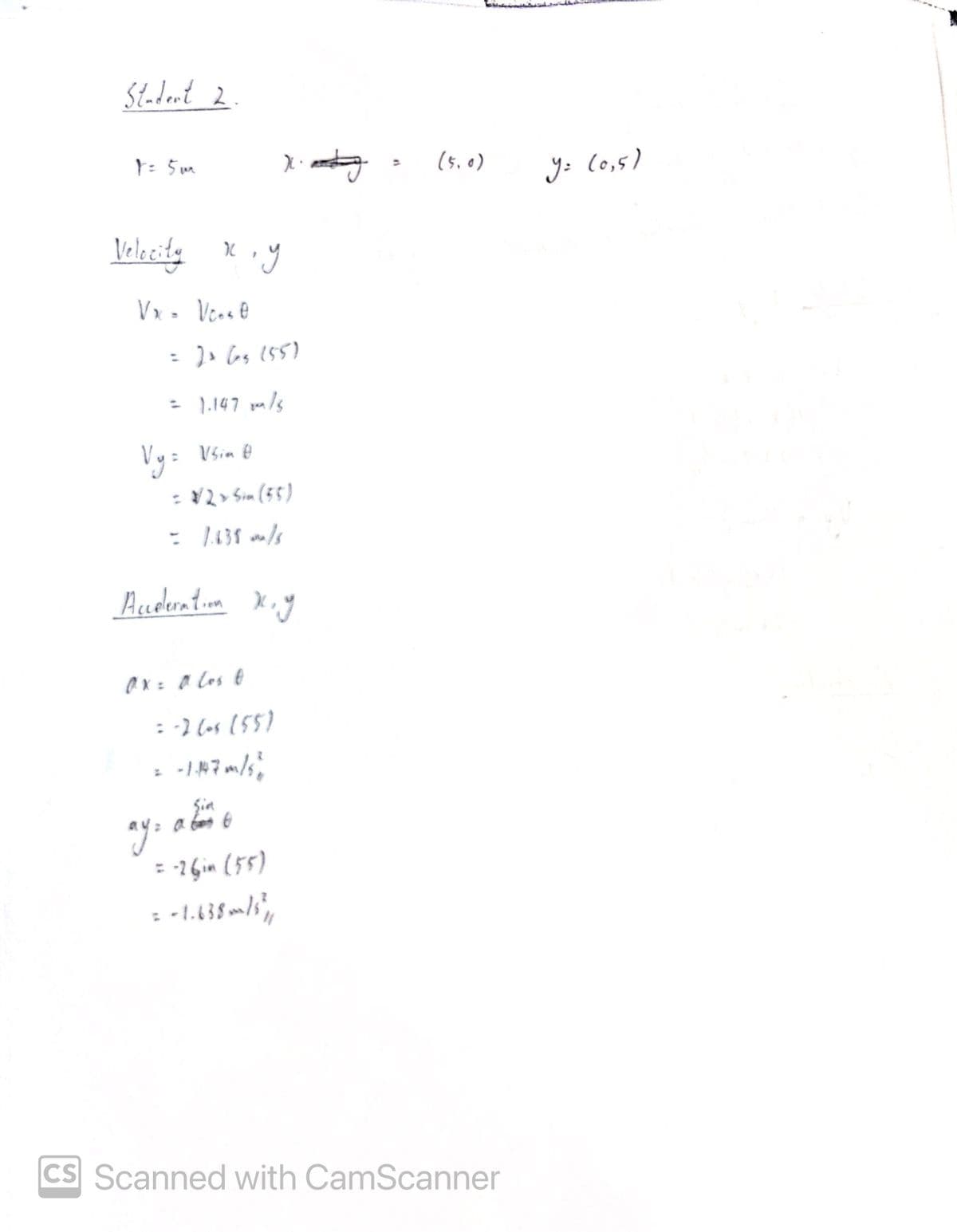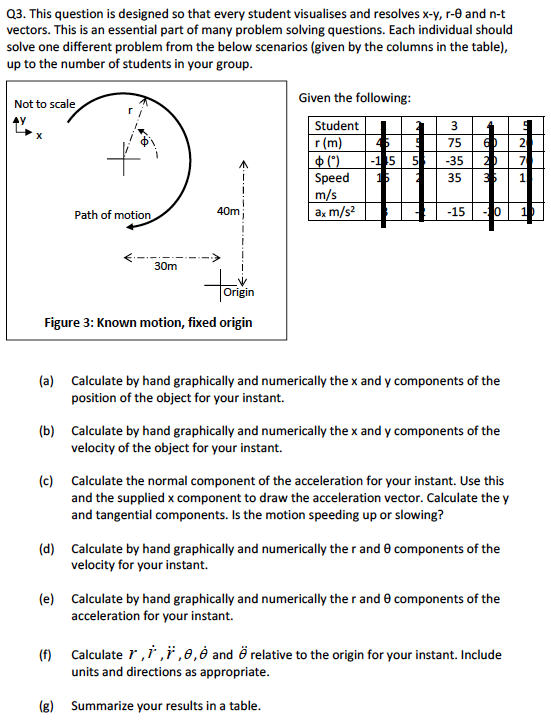Q3. This question is designed so that every student visualises and resolves x-y, r-0 and n-t vectors. This is an essential part of many problem solving questions. Each individual should solve one different problem from the below scenarios (given by the columns in the table), up to the number of students in your group. Not to scale Given the following: Student r (m) |-15 5 3 75 2 |$ (*) Speed m/s a, m/s² -35 35 Path of motion 40m -15 30m Origin Figure 3: Known motion, fixed origin (a) Calculate by hand graphically and numerically the x and y components of the position of the object for your instant. (b) Calculate by hand graphically and numerically the x and y components of the velocity of the object for your instant. (c) Calculate the normal component of the acceleration for your instant. Use this and the supplied x component to draw the acceleration vector. Calculate the y and tangential components. Is the motion speeding up or slowing?
Q3. This question is designed so that every student visualises and resolves x-y, r-0 and n-t vectors. This is an essential part of many problem solving questions. Each individual should solve one different problem from the below scenarios (given by the columns in the table), up to the number of students in your group. Not to scale Given the following: Student r (m) |-15 5 3 75 2 |$ (*) Speed m/s a, m/s² -35 35 Path of motion 40m -15 30m Origin Figure 3: Known motion, fixed origin (a) Calculate by hand graphically and numerically the x and y components of the position of the object for your instant. (b) Calculate by hand graphically and numerically the x and y components of the velocity of the object for your instant. (c) Calculate the normal component of the acceleration for your instant. Use this and the supplied x component to draw the acceleration vector. Calculate the y and tangential components. Is the motion speeding up or slowing?
Elements Of Electromagnetics
7th Edition
ISBN:9780190698614
Author:Sadiku, Matthew N. O.
Publisher:Sadiku, Matthew N. O.
ChapterMA: Math Assessment
Section: Chapter Questions
Problem 1.1MA
Related questions
Question
100%
please answer a to g for student 3. thanks

Transcribed Image Text:Stadent 2
T: 5 m
(5,0)
y: (0,5)
Valecity
Vx . Vens e
) bs 155)
%3D
- ).147 pen /s
Vy=
%3D
- ¥2> Sim (55)
- 1138 m/s
Acuderatiom
O X = a los @
: -) los (55)
Şin
= 1 Gin (55)
CS Scanned with CamScanner

Transcribed Image Text:Q3. This question is designed so that every student visualises and resolves x-y, r-0 and n-t
vectors. This is an essential part of many problem solving questions. Each individual should
solve one different problem from the below scenarios (given by the columns in the table),
up to the number of students in your group.
Given the following:
Not to scale
Student
r (m)
$ (*)
60
20
46
75
2
-15
5
-35
7
Speed
16
35
1
m/s
ax m/s?
Path of motion
40m
-15
-10
10
30m
Origin
Figure 3: Known motion, fixed origin
(a) Calculate by hand graphically and numerically the x and y components of the
position of the object for your instant.
(b) Calculate by hand graphically and numerically the x and y components of the
velocity of the object for your instant.
(c) Calculate the normal component of the acceleration for your instant. Use this
and the supplied x component to draw the acceleration vector. Calculate the y
and tangential components. Is the motion speeding up or slowing?
(d) Calculate by hand graphically and numerically the r and 0 components of the
velocity for your instant.
(e) Calculate by hand graphically and numerically the r and 0 components of the
acceleration for your instant.
(f) Calculate r,i ,ï ,0,è and ë relative to the origin for your instant. Include
units and directions as appropriate.
(g) Summarize your results in a table.
Expert Solution
This question has been solved!
Explore an expertly crafted, step-by-step solution for a thorough understanding of key concepts.
Step by step
Solved in 3 steps with 3 images

Knowledge Booster
Learn more about
Need a deep-dive on the concept behind this application? Look no further. Learn more about this topic, mechanical-engineering and related others by exploring similar questions and additional content below.Recommended textbooks for you

Elements Of Electromagnetics
Mechanical Engineering
ISBN:
9780190698614
Author:
Sadiku, Matthew N. O.
Publisher:
Oxford University Press

Mechanics of Materials (10th Edition)
Mechanical Engineering
ISBN:
9780134319650
Author:
Russell C. Hibbeler
Publisher:
PEARSON

Thermodynamics: An Engineering Approach
Mechanical Engineering
ISBN:
9781259822674
Author:
Yunus A. Cengel Dr., Michael A. Boles
Publisher:
McGraw-Hill Education

Elements Of Electromagnetics
Mechanical Engineering
ISBN:
9780190698614
Author:
Sadiku, Matthew N. O.
Publisher:
Oxford University Press

Mechanics of Materials (10th Edition)
Mechanical Engineering
ISBN:
9780134319650
Author:
Russell C. Hibbeler
Publisher:
PEARSON

Thermodynamics: An Engineering Approach
Mechanical Engineering
ISBN:
9781259822674
Author:
Yunus A. Cengel Dr., Michael A. Boles
Publisher:
McGraw-Hill Education

Control Systems Engineering
Mechanical Engineering
ISBN:
9781118170519
Author:
Norman S. Nise
Publisher:
WILEY

Mechanics of Materials (MindTap Course List)
Mechanical Engineering
ISBN:
9781337093347
Author:
Barry J. Goodno, James M. Gere
Publisher:
Cengage Learning

Engineering Mechanics: Statics
Mechanical Engineering
ISBN:
9781118807330
Author:
James L. Meriam, L. G. Kraige, J. N. Bolton
Publisher:
WILEY